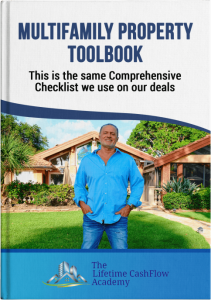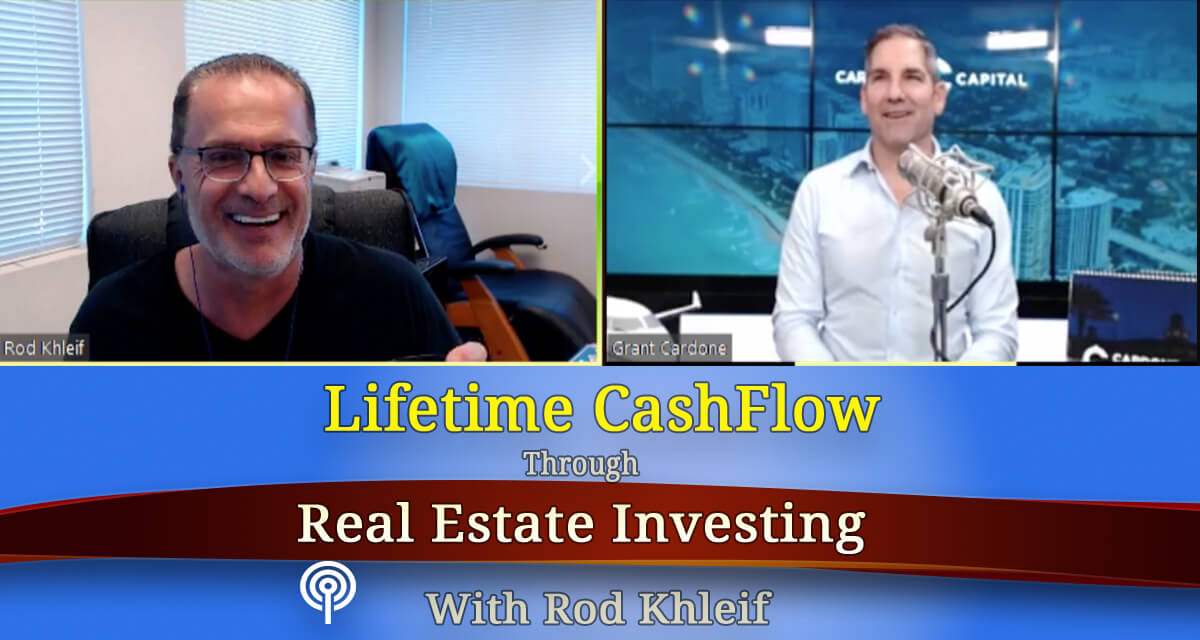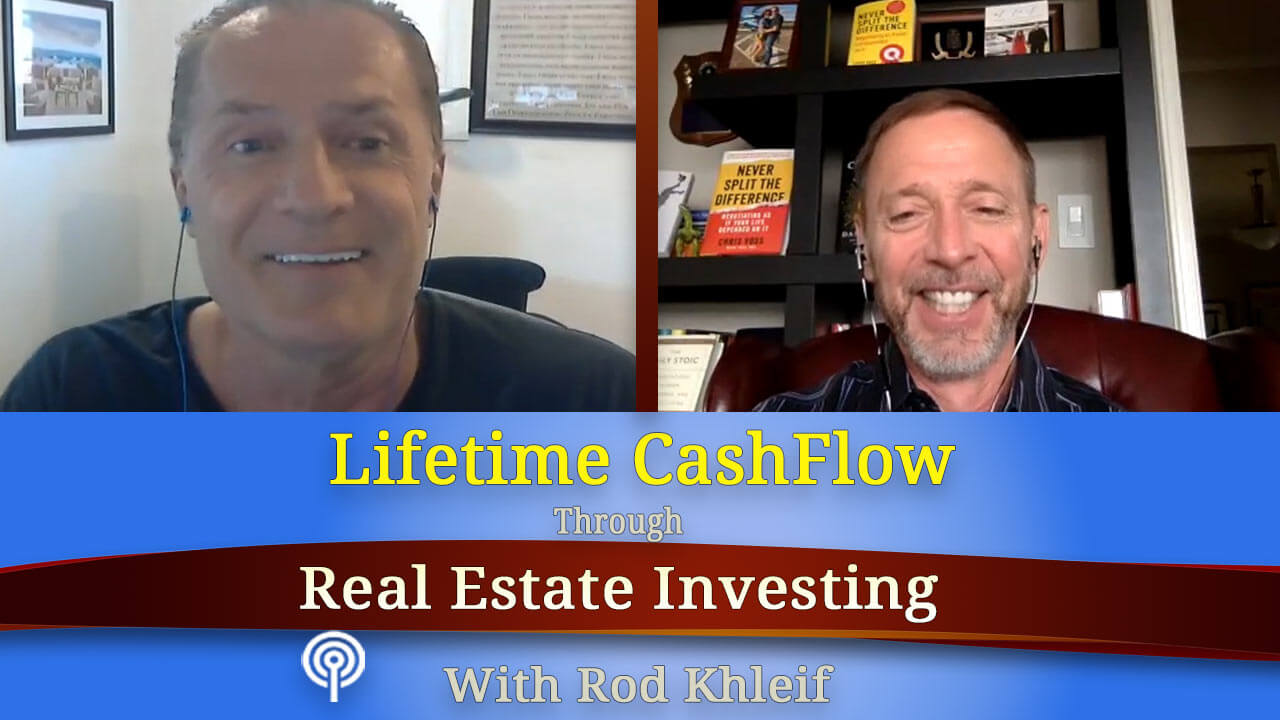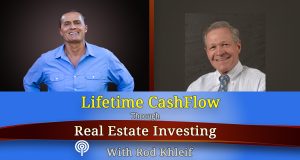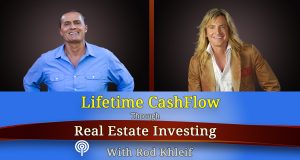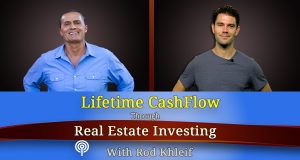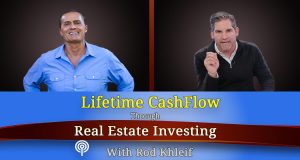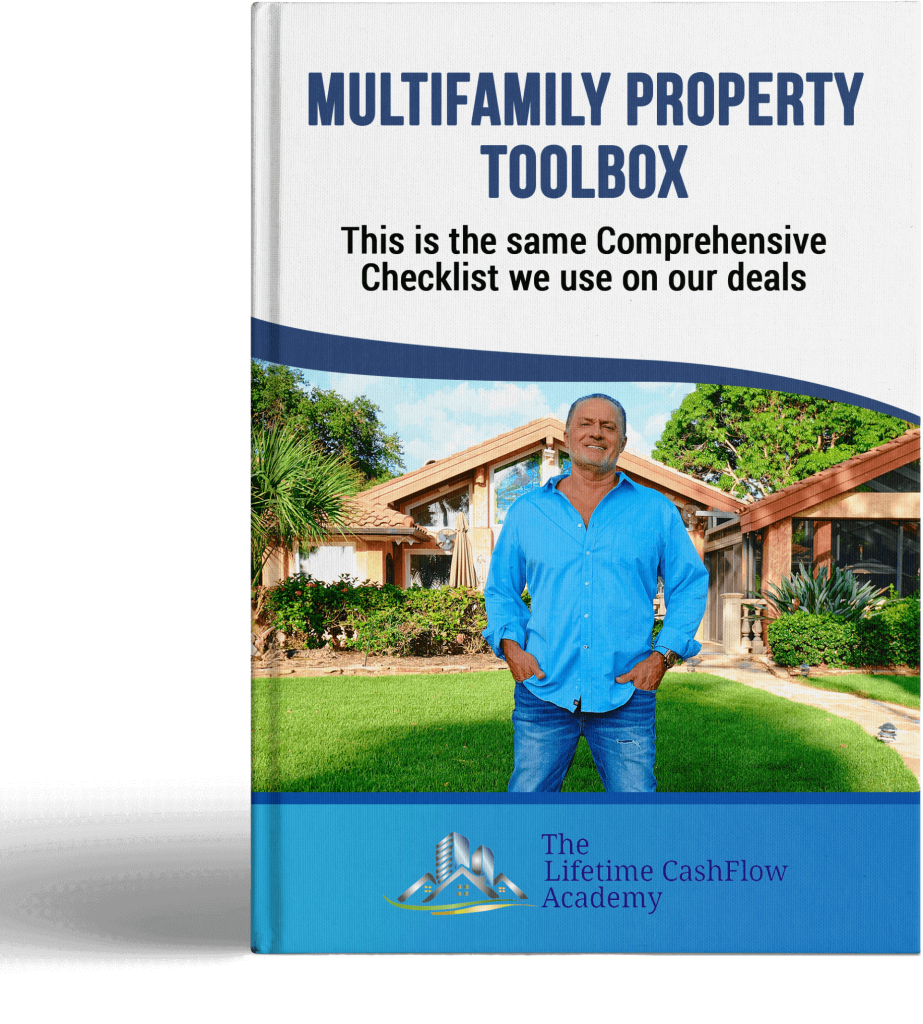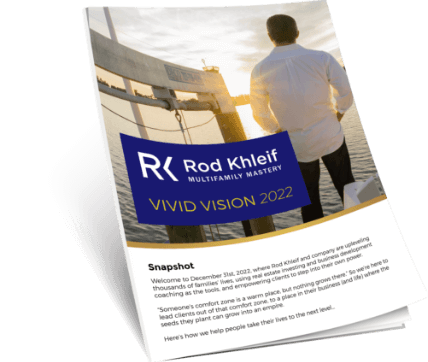Ep #469 – Robert Ritzenthaler – Deconstructing Successful Multifamily Deals
Rod and Robert deconstruct recent assets they have purchased and what they look for in a property to invest in.
- Jobs drive multifamily
- Keeping an eye on the path to progress
- The three things that should be growing in a market
- Free resources to find demographic data
- Understanding income to rent ratios
- Looking at employment diversity
- Creating your business plan
- The value of national chains close by
- Easy fixes make a huge impact
- Simple value add renovations
Robert is partners with Rod in REM Capital
To find out more about our guest click here.
Full Transcript Below
Ep #469 – Deconstructing Successful Multifamily Deals – Robert Ritzenthaler
Rod: Welcome to another edition of How to Build Lifetime Cashflow through Real Estate Investing. I’m Rod Khleif and I am thrilled you’re here. And we’re gonna have a lot of fun today. I’ve got my partner, Robert Ritzenthaler on with us today. And if you don’t know, Robert, he’s a CPA. He’s done over a billion dollars worth of commercial real estate so far in his career. And we’ve been having a lot of fun the last few years. In fact, we’ve purchased over 1,400 units with our students in the last say 18 months. So maybe two years actually to be precise. But anyway, welcome to the show, buddy.
Robert: Good to be here.
Rod: All right
Robert: Good to be back.
Rod: Good to be back. Yeah. So what I was thinking, so guys, I’m thinking that this interview is going to be a little more technical than most of the ones that I do because what I’d like to do is we recently closed on a couple of assets. One in Oakwood, Georgia, which is a suburb of Atlanta, kind of north east of Atlanta, and then another one in Cincinnati and we’ll start with the one in Oakwood, near Atlanta. And what I’d like to do is really speak to what we look for in a deal and what we look for in a market, in a sub market and in a deal and kind of give you some kind of an overview as it were. So that when you’re, you know, out there hunting for deals, you can get an idea of what we look for. So, all right, well, let’s, start with legacy at Audubon Crest. Why don’t you talk about that asset a little bit. And then yeah, we’ll get into it.
Robert: And that one’s a pretty easy one because a lot of people know about Atlanta. But you still use the same criteria. The other thing I would say though, is that you know, whenever you go into a new market, it’s always important to do a lot of research, really get to know the market. I know a lot of people you know, they know their backyard. Of course, you talk about the law, which is great start in your backyard, and you take for granted all the things that you know in your backyard. So, it’s important to document all those different points when you go into a new market. And even in Atlanta, you know, like this deal, there’s probably I don’t know, a dozen different sub markets around Atlanta downtown, you know, west side of downtown, there’s just all these different sub markets. Everyone has a unique aspect to it for different asset classes and that kind of thing. So,
Rod: Demographics
Robert: Yeah
Rod: Yeah, you know, some of the areas near urban may lend themselves to singles that only need one bedrooms versus families you know, out in the burbs so
Robert: Exactly
Rod: as things come into play. So, so I know this is 126 unit value add deal. Maybe you could talk, let’s start with the greater area around it. Let’s work from the area into the asset. So, do you mind talking about why we liked this market and sub market?
Robert: Yep. Yeah. So, the big thing, of course, that we always talk about is that jobs drive multifamily. So that’s kind of the starting point, where are the jobs? Where’s the job growth, where’s the income growth, and try to follow that. Now, that doesn’t mean that you can’t make money in areas that aren’t necessarily top 10. But those are the areas that you absolutely can make money. The challenge of those areas, of course, is that a lot of times you’ve got everybody looking at that area, so it’s hard to find value. So that’s where if you do find a property in an area like that, that is priced reasonably, it’s kind of a well I don’t want to say it’s a no brainer, but it certainly makes me
Rod: Want to jump on it quickly.
Robert: Right, so from this particular, you know from Oakwood, it’s kind of an interesting situation because you’ve got the Atlanta Metro that’s coming up, any of you guys who know the Atlanta area, we’re looking at a map, you’ve got 85 that comes out of Atlanta, and you’ve got that Metro, you know, coming out of 85, Pass the loop and all the way up to I think it’s like Deluce. I forget what the exact pounds are out there. But anyway, it’s in Gwinnett County. So, if you look up Gwinnett County, you’ll see that. So you’ve got that growth on the southwest side of this, this Oakwood area. And then on the north, east side, you have Gainesville, Georgia. Now, Gainesville, Georgia is smaller town, but it’s growing, lot of development, a lot of job growth, very pro-business, and they’ve been growing a lot. So, we’re right in between, this particular is right in between those two growth markets. And so, from a sort of path of progress perspective, you almost couldn’t ask for a nicer set of circumstances to be in.
Rod: It’s coming both ways. Right.
Robert: Exactly. Exactly. So, it’s kind of cool and you know, a little bit like, if you think of Dallas Fort Worth and you know, Grand Prairie and Arlington in some of those areas in the middle, you’ve got that, you’ve got both sides that you’re pulling from. So it’s kind of a great mix. But anyway, so that was kind of the big picture that we started with. And then as you break it down into more of a local demographic or job base, I guess, if you will, you know, there’s things like Amazon putting in a hub, and there’s corporate headquarters for Fortune 500 companies, and there’s, you know, half a billion dollars coming into Hall County, which is the Gainesville, the county where Gainesville is that. So there’s a lot of things like that they really drive an investment thesis for us. So that’s kind of like
Rod: So you’re looking guys for three things to be growing in a market, population, income and jobs and of course, the most important is jobs. And so, when you see the local government investing money, you see investors investing money, you see new business coming in like this Amazon, you know, one of these Amazon fulfillment centers, which, you know, they’re there they go in under the radar because they, you know, they’re trying to build reach as fast as they can. But, you know, these are big deals that are happening and so, you know and then you know you what we like to look for is employment diversity and, dare I say recession resistant employment diversity. Okay, especially with what’s happening right now. So, you know, there are I know here we’ve got, you know, quite a few large companies. We’ve got higher education as a university in North Georgia. We’ve got medical, you know, there’s the Georgia Medical Center there’s things of that nature there’s some plants there that are manufacturing plants like ours and Wrigley has a plant and some other things like that. And these are the kinds of things as well that you know, when you’re speaking to your investors about a deal, you know, you need to know. You need to know what’s happening there. You need to know what’s growing. So how do they find this information Robert? Let’s drill down on this, just a hair
Robert: Yeah, no, great point a lot of free resources out there that anybody can pull. We use them just like everybody else BestPlaces.net, city-data.com. The other one that you and I always, like is datausa.io, I think. I mean, there’s others out there too, but those are great resources to start with.
Rod: Yes. So guys, what you do is you just plug in the market you’re interested in and, you know, it’s not really, don’t be overwhelmed by it, it’s actually pretty straightforward when you get in there and you can you can identify the trends that are happening in these different you know, things that you need to be monitoring like, like I just said population, income, jobs, you know, median house income, you know, look the area rental amount. Speak to what we look for, between the, the sorry,
Robert: Ratio?
Rod: Yeah, ratio between not just income and income and also home price, median
Robert: Home value, yeah. So that’s important. Well, and let me, before I do that, let me piggyback on what we’re talking about those resources. So, and I know you’re feeling the same way. There’s nothing that compares with getting on the phone. First of all, do your homework and just driving the area. So, you know, driving and of course, his little easy you can see things but getting on the phone with like the Economic Development Council, if they have one for the Chamber of Commerce, exactly. You really, you just have to do that. Put it on a checklist and just do it, make friends, get to know people at those two organizations and find out what’s happening and you’ll get a ton of great information. So just want to put that plug in there.
Rod: That’s good and then
Robert: Yeah back to what you were saying. So, in terms of those ratios, you know, one of the things that we found is that generally speaking, in income level of somewhere between 35,000 and 55,000 is kind of a sweet spot. Somebody may say, Well, gosh, you know, if somebody makes 100 grand, isn’t that better? Well, it’s not because those people could very easily go and buy a house. So again, and this is somewhat dependent on the, the asset class that you’re going after. So if you’re doing, you know, brand new class A development, okay, yeah, you want to look for this hundred thousand dollar income folks. But if you’re doing, you know, B-C value add anything in that neighborhood, we’ve kind of found that that 35,000 to 55,000 salary for most the country. I mean, again, San Francisco, LA, those kind of places are an exception. It’s a very kind of a sweet spot. But you want to find places where people’s income is about three to maybe four times the rent that you’re going to charge and a property management company’s going to do that anyway. But you want to see that you want to see that there’s upside and there’s ability for people to pay the rent. And then the flip side to what you were saying about the median home value. If you’re paying 50,000 a door as an example, and your median home price is 100,000 or 150,000. That’s a good ratio. If you’re paying 150,000, a door and your median home price 150,000 that’s not a good ratio. So, we typically have a, well, exactly because you know, somebody can go buy a house for just as much as they could, they could essentially rent something and apartment. So it’s a very easy trade off, you’re gonna have high turnover.
Rod: Right
Robert: We always try to look for, if we can ideally double for buying for 50 a door, we want the home price to be 100. Obviously, the more the better.
Rod: Right. Talk about, you know, do you have any metrics around when you’re looking at different growth levels like population, income, employment? Do you have any barometers for the sorts of growth that you like to see? And over what period of time?
Robert: Yes and no. And I know a lot of people say, you know, I got ahead 10% growth, I’m not even gonna go into that market. Nothing wrong with that. I think the difference is that, if you have those rules, they are good because they kind of allow especially somebody who’s newer into the business, they allow you to make some mistakes and still be okay. So, I wouldn’t recommend somebody who’s newer going into a call it a Dayton, Ohio, because that’s a very specialized market, you got to know exactly what neighborhood, what area you’re going into, or else you can get burned. So, right, you know, like Atlanta, probably a good example anywhere you look in Atlanta is a very high growth market. So, you know, you can go south side, North Side, East Side, West Side, and you’re probably going to be okay, you know, if you hold it for, call it five years. But there is, it is important to be able to break that down and really look locally at what’s happening in your area so that you do know what you’re getting into. But all that being said, if an area doesn’t have a population growth, it doesn’t necessarily mean that you cannot invest there. What you have to do then is look at the new inventory. Because if you’ve got a million units coming online, and the area’s not growing, you got a big problem.
Rod: It’s a supply and demand issue.
Robert: Exactly. Exactly. So it takes kind of another step. And you know, interesting enough, even if you’re in a high growth market, if you’ve got too much inventory coming in, this happened sometimes in Dallas, because that’s where I grew up so I saw it, you can have problems there, you could have a 20% growth, but the inventory is growing at 30%-40%. At some point, the needle starts to go the wrong way. And the whole thing comes crashing down. So
Rod: Okay, okay, good. So, but I know that this particular property had kind of off the charts employment growth. And, you know, where the average is in the single digits, and this thing was at, like, 21% or something so
Robert: Right. Yeah. Very high. Very high. Yeah unusually high
Rod: Right. Now, one of the other things I know you always pay attention to is what happens to unemployment. You like to look at that historically. And compare it to the state and then also compared to the country. Can you speak to that a little bit?
Robert: Yeah, yeah, we like to go back. I think that data that we have is 28 years, you know, 29 years, something like that. And I think that’s really a great barometer because you’re looking at something that is over a long period of time. And it kind of gives you again, it’s not an end all be all, but it kind of gives you an idea how is this area done relative to the areas around it? Are the jobs relatively resilient? Did they outperform in the last two economic downturns? And, you know, some areas they could change and they go from underperforming and now they’ve made some changes or the leadership in the area has changed. And actually, you know, while we’re talking about that, I think it’s also important, again, real estate for local, it’s really important to know your leadership, and that’s why calling the Chamber the Economic Development Council, who is the mayor, that kind of thing can make a big difference. Because if you got good leadership at the top, even if you’re in an area that doesn’t have super high population growth, that can actually make a tremendous difference and vice versa.
Rod: Well, okay, yeah, and vice versa can be the opposite of that. It can go the other way. Well, so when you when you make that statement, how does someone determine just by finding out who the mayor is? The quality of that leadership, do you ask? I mean, you just ask the chamber, you know, what are they up to? What are they doing? Are they trying to create a stimulus? Are they trying to get jobs in? try to think about the initiatives? asked about the initiatives are up to?
Robert: Exactly. Yeah, everything economically related to say, Hey, what’s happened in the town? What’s happening with the, you know, what’s the mayor pushing with the Board of County Commissioners or whoever they, you know, whatever the legal body is. You know, tax rates, pro-business, you get a feel for pretty quickly. And if the area is sort of, you know, lukewarm on business growth, you’ll get the sense that it’s not probably going to grow.
Rod: Right. And I just sort of circle back to jobs for a minute. I know that you know, we look we look for multiple recession resistant employment industries
Robert: Absolutely.
Rod: And we want to see a wide range of options. We don’t want a one horse town, we don’t want to just where you know, where it’s one big employer and even a military base, we don’t want to see that. We want to see multiple employers employment basis and again, you know, we don’t want to see all retail for example, you know, and because of, you know, I mean that’s how I got crushed in ‘08 actually. It was retail and construction where the bulk of my residents and that all that fell off a cliff and so, you know, obviously with COVID, it’s tourism, it’s restaurants, it’s all these things, and that are going to impact things but, you know, like, like this particular week I’m looking at a sheet you did on the county that this property is in Hall County and it’s got, you know, it’s very diverse, like there was a 14% in production 12% sales, 88% management, construction was 6.5%, education was 6%, food prep was 4%. You know, there’s lots of different types of industry. And, and certainly lots of things happening.
Robert: Yeah. Yeah. And that’s what you want. That’s the one. You know, going back to what you were saying about a one horse town. You know, we’ve looked at deals, as you know, in Killeen, Texas, which is basically a military town, Fayetteville, North Carolina military town. Do I think that those military bases are going away? No, I think they’re gonna stay there. But still, there’s an additional risk that’s associated with that, because the military could say, I mean, I’m not trying to point fingers or anything, but you know, elections come up and the person says, you know, what, I’m cutting the budget 10% or 20%, that can have a big effect on that, that local economy. So you know, just again, not to say that you couldn’t, but you know, we’re big fans of diversify that out so that you’re protected and like you said, some jobs are much more recession resistant than others. Historically speaking, tourism goes because people don’t have money to take vacations. You know, we’ve known about retail for the last 20-30 years as the internet’s gone up, and the bricks and mortar have gone down. So that’s not new.
Rod: Right. We’ll say this, COVID is thrown that on its ear. I mean, lots of friends that own retail strip centers, and the number I’m hearing from all of them is they’re about 75% of their of their tenants are asking for rent abatement, and if you can’t pay your mortgage with those kinds of numbers, so there’s going to be some that’s incredible pain in that in that market. But back to this autumn on property in, you know, in Hall County, Georgia, I mean, there’s like there’s a big Medical Center, it has over 8,000 employees, there’s, there’s the school system has 3,500 employees, and then, you know, and then the government there has 1,700 employees and there’s different manufacturing, so, you know, very diverse. So now, let’s talk about the property specifically, Robert, and why we love it. And we’re so happy to have it now. Can you speak to a little bit?
Robert: Sure, this one was a little bit easier than some. As you know, we do some that are a little bit more of a, you might say, a heavier lift, right, this would be a little bit of a lighter lift, a little nicer quality. Again, you pay a little bit more, but, you know, there’s good to both, there’s good to both, especially, again, I would say for folks that are maybe newer wanting to get into business, sometimes you kind of have to start with those more hairy deals because you get a little better price. You put your sweat equity into it and you slowly kind of work your way up. Nothing wrong with that. But this one was nice because it’s a newer build, you know, built back in 2000-2001. So relatively newer build and nice looking curb appeal,
Rod: Gorgeous
Robert: Right nice property. And so one of the things that we found literally by driving in the entrance and driving, I mean, literally, you could see it in five minutes. With it the level of care was not commensurate with where the property could be. So, he’s basically being led to slowly slide back. And of course, if you give it another 20 years, it would have been a true C- property that didn’t have to be there. So, you know, we kind of caught it before it got to that point, which is nice. But yeah, so that was a that was an easy one.
Rod: It’ll be an A asset when we’re done.
Robert: Absolutely 100%
Rod: We’ll talk about the business plan there and by the way, guys, anytime you buy a business, you have to have a plan and the apartment community is no exception. Okay? So you have to create a business plan as to what you plan to do. So we’ll talk about that in a minute.
Robert: But it doesn’t need to be a 95 page business plan, either
Rod: Oh, no, no, no, no. So you know, what do you plan to fix up and what’s the impact going to be on the rents? How do you plan to, you know, minimize expenses? It’s really those are the only two things so you’re going to increase rents or minimize expenses? So how do you do it? That’s the business plan. But you have to have that. You have to know you know what you’re going to do, what you’re going to spend and you know you have to have done your homework to know that when you do these things they’re going to impact and how they’re going to impact your rents. But before we go there, I do want to mention this in and this is really important at least for us. We always look for assets that have National Retail tenants around them okay. And so you know, we love seeing Starbucks, Whole Foods, you know, things of that nature. But we want to see National Retail tenants around our properties. We don’t want to see localized you know, burger and sushi combined place or something like that. You know we want we want to see you know the national fast food chains and ideally you know, we want to see Walmart’s. We want to see nice grocery stores all of that so pay attention to that, guys. But anyway, go ahead.
Robert: Well, as you’re saying, there’s two reasons for that. One is credit. And the other is research. So those national tenants typically do a lot of research, they spend a lot of money researching the area. So, you’re kind of saying, hey, they did their research, they know this is a good area. Not that that’s the only thing but it’s certainly, you know,
Rod: It’s huge, huge. These guys spend a lot of money checking out the demographics and the income and the traffic patterns and all these other things that come into play in their businesses that affect, you know, multifamily, I mean, that are similar to multifamily. So,
Robert: And like I said too, the credit is the other thing. Your local again, nothing against the local, I love local, we support local, but those national retailers and those national tenants, they usually have a deeper pocket. So, they’re able to withstand a situation like we’re going through today, much better than the smaller guys. And so again, it kind of mitigates some of the retail risk in your area as well.
Starbucks, for instance, the one up in front of Audubon, they’re not shutting down, you know, they’re gonna be there, they they’re gonna withstand this, there’ll be fine. A local coffee shop, they probably be out of business by now. Now, they might come back, but you know, they’re gonna get hit a lot harder.
Rod: Yeah, that’s a really good point. That’s a really good point. I didn’t think about that, you know, this particular asset has you know, like four Starbucks within five or six mile radius of this property down the main drag and you know, Robert and I talk a joke that we should you know, own stock in Howard’s company there but,
Robert: But we’ve only been to two of those four, so
Rod: Yeah we’re slipping. So why don’t you speak to you know, what we saw as far as the numbers on this place, so you know, with well you know, I can briefly speak to the amenities I mean, this has got nice amenities a pool and the fitness center, playground and you know, tennis court even which is not as common and you know, of course, outdoor barbecue stations and things like that. So, you know, some really nice stuff that you want to see, if you’re going to really turn a property into an A asset, you’re going to want nice amenities like that. But why don’t just to the unit mix there and the kind of rent bump that we were anticipating, and then the good news about how well this thing did before we even closed.
Robert: Oh, right. Yeah, well, I’ll go back to the amenities real quick to kind of funny you mentioned the barbecue pit. I think you were there when I was taking a picture of it. It literally been left there and rusted off.
Rod: It was rusted completely out, right. I know but you know, and we’re going to have
Robert: It’s a $100 fix
Rod: Right. Just do it. Sometimes you see and you go through these properties, you’re like, what were they thinking? This has nothing to fix and it’s such an eyesore. And, you know, we see that with pools and I remember that Texas asset that we bought and the pool was closed because they were too lazy to fix the freakin fence. It was nothing to fix. It was 100% occupied but these people didn’t have a pool because this, yeah, just head scratching stupid stuff.
Robert: I don’t know if I mentioned to you but this Audubon, same exact situation. So the gate latch, well, yeah, the gate latch wasn’t working and the pool pump was broken. So, what did we literally do the week after we took over? We got the gate latch fixed, and we replaced the pool pump. And now it’s working again. I mean, that easy.
Rod: And that’s nothing fix as crazy. Wow. And so, you know, obviously we’re excited when we see assets that have these kinds of things, you know, that haven’t been taken care of because they are easy fixes. Yeah, of course there are other things that are going to be more expensive to take care of but you know, when your residents see that, they’re not going to stay they realize you have no pride of ownership, you’re not taking care of the place, you don’t care about them. And what’s your biggest expense? Your biggest expenses turnover, and you spend a little money to take care of your residence and take care of your property and you and you greatly mitigate the turnover.
Robert: I got another funny story for you with regard to residents. I don’t know if I mentioned this. So I was I sat down with our onsite manager and I said, hey, you know, we’re going to, we’re going to start to raise rents renovate the units. And I think we’ll probably be pushing the resident demographic a little bit, you know, kind of trying to bring in some folks have a little, little higher income. And I said, Do you feel like we need to change our marketing approach? Do you feel like we need to do something to pull those types of residents in? And she said, No, no, we’re getting those. And I said, Oh, really? Okay. Well, why aren’t they renting? And she said, Well, you know, the side of the building as we all we know, because we’re talking about pressure washing, it was all green from mold that just never been pressure washed. And so, I said, Wait a minute, so you’re telling me that this pressure washing that is probably already done, especially done this week, is literally the difference between somebody saying, sure, I’ll pay an extra hundred dollars and stay here and not? She’s like, yeah, in some cases, yes. So, you know, again, you know, we’re gonna do the renovation everything but it’s just kind of funny when somebody literally can equate those two and they’re walking around the person says yeah what’s up with that green wall? That’s not cool. I’m going somewhere else. I mean
Rod: Right you can’t make this stuff up guys and so much of this is just literally common sense. Truly, you got to put your common sense hat on and look at that property and say to yourself, you know what I want to live here and you know, what little things can we do to dress them up and you know, like, we’ve got an asset in Louisiana and we hired a porter and the porter is going to stripe the parking lot on the drive in which will greatly enhance the look of that place. It’s just little things that you can do that may be putting flags in front of the leasing office and on the route in and really dressing things up but definitely maintenance as well. So
Robert: You have to bring up Freeport, didn’t you?
Rod: Yeah, I did. You guys we’ve been spending a lot of time with this particular asset that has been a problem. We won’t go into the detail of it right now but the but the point is, you know, Robert and I spent five of the last seven weeks there. And Roberts going Monday and I’m going a week from Monday but it’s a,
Robert: It’s a cool turnaround project though
Rod: It’s a lot of fun
Robert: Crazy work but
Rod: It’s a lot of work and it’s a lot of fun. It’s a 403 unit asset that you know, we had a different management company in place connected to a partner that we had and it took a long time to get them out of there. We got them out of there and we have just really made a huge difference there. So, it’s exciting to see what’s happening there and the leasing and the make ready and the delight of the tenants to see what we’re doing to that places is really kind of cool to see and we’re turning it around but
Robert: And I think Rod, well just real quick because I think that brings up a great point really and again, I think a lot of the listeners would probably benefit. So that’s in a market that’s not growing. There isn’t some you know, crazy population growth etc, etc. But I really believe, I know we both believe this by I’m convinced we’re gonna make good money.
Rod: We’re gonna make a ton of money. So you know, yeah, I mean like to the tune of eight or nine million dollars once it’s all said and done and that’s without even raising the rents. We just have to get the occupancy up to 90% which we will. It’s the nicest product we call it product guys when you’re when you’re talking about your assets, your properties it’s a nicest product in that market for sure. Biggest units, nicest layouts, nicest amenities, it’s just was horribly managed and now it’s not so
Robert: You can find you can find opportunities like that in a flat growth market where you can buy for good price, poorly managed, and you know, bring a little money in turn the place around, you can make good money. So you know, again, that’s why I say it doesn’t have to be this Atlanta top growth market. You can get into the business and you know, you got to be careful you got to know your numbers.
Rod: Let me get a caveat because most of my listeners are fairly new Robert so I would encourage you to try to find a market that has that growth rather than going after a market like Shreveport, Louisiana right now because you’re just, it’s easier to achieve that success and I don’t wanna
Robert: Agree. The wind is in the right direction.
Rod: Exactly, you want to surf that wave instead of getting crushed by it.
Robert: Right.
Rod: Okay, so this property has a nice unit mix. I believe it’s,
Robert: yeah, mostly twos
Rod: Mostly twos. It’s 126 units. It’s got 21 bedrooms and 32 two-three bedrooms, but the rest are all tubes like 70 to 74 two bedrooms, and which suits that demographic, they’re perfectly it’s a little bit of everything there. You’ve got, you know, you’ve got single people, you’ve got small families and it suits that demographic perfectly. Nice, you know, they’ve got nice floor plans and you want to look at the floor plan you want to get in there. What are the rooms sizes? You know, do they have washer dryer hookups, for example, you know, and things of that nature. But
Robert: That’s one of the biggest things for a suburban property I would say
Rod: which is?
Robert: Dryer hookups, not always in in a downtown you know, urban area. Sometimes you can get away with that. Unless you’re in the B class or the A class, I think you’re going to need it. But for sure, in a suburban type property, you’re going to want to either have a washer dryer hookup or have the ability to put it in. I would highly recommend that though still.
Rod: Yep. So let’s shift over to the business plan for this. You know, what did we see and what are we going to change to effectuate our plan here? And what are we going to do?
Robert: Sure. So, the biggest thing again comes back to opportunity at the property in the local level. So everything around us is basically not everything but there’s a lot of A class properties around this nice properties well capped much higher rents. So again, our thought was, hey, we’ve got this very high demand for residents they’re willing to pay more money. All we need to do is go in there and upgrade our units pressure wash our building, put a latch on the floor
Rod: Put a barbeque in
Robert: You know, I mean, smaller stuff and big both right? I mean, details, details important too. But the basically the ideas come in, provide good management, upgrade the interiors, and then go back to market and say, hey, guys, listen, we’re over here. And we’ll provide a great value for you, good size unit, you know, we’ll still be a little bit below market rents even after we do our renovations, and it’s a beautiful complex. So I mean, that’s the business plan in a nutshell. Now, of course, when you get into it, you got decisions like, well, you’re going to do granite countertops, you’re going to do a tub surround or backsplash. A lot of that. We will actually do a test unit. We’ll take a unit, do what we think works, we’ll test it in the market get you know 10-20 people get a shout get a bunch of showings kind of get some feedback. If everybody comes through and says yeah I don’t care about the granite countertop but wow I love that tub surround. And sometimes we may you know, we’ll do 2,3,4, or five units, see how it goes say well if we don’t need the granite maybe we won’t do it, you know, those kind of things. So that’s kind of how we do it on a practical level.
Rod: Here’s some of the things that you know that most operators do you know, when they’re looking at doing when they’re doing a value add so things like you know, maybe painting the cabinet doors are putting new cabinet doors on you know, new fixtures, you know, and the plumbing and electrical you know, the lightning bolts or maybe new hardware on the doors. Like Robert said, new countertops or maybe resurfacing the countertops even sometimes that looks good. We’re doing that at Shreveport. LVT flooring, you know the vinyl flooring that looks really nice. Of course, paint inside and out, you know, and maybe striping the parking lot and resurfacing the parking lot. Some of the other things we mentioned, but you know, our business plan for this particular asset is to turn it into, is to take it from a B into an A asset, which we believe we can do because the market supports it. So, yeah, and then, you know, we’re looking at, what sort of a rent bump are we looking for on this one?
Robert: Will probably be somewhere between 150 to 200. I think once we get post COVID if there is such a thing, I think it’ll be more than that. But we’ve, I think, realistically, that’s where we sit today. Still a good amount for sure.
Rod: Sure, hang on. I’m just gonna do something real quick
Robert: Doing the math?
Rod: I’ll do the math. Yeah, right now… Yeah, I mean, if we do $150 rent bump to give you guys an idea. You know, that’ll drop right to the bottom line. And that’s a, you know, $3.8 million increase in value. So it’s a big deal. You know, that’s just why we love this business guys. And, you know, who knows with COVID, if we’ll be able to go that, you know, to 200 or more, how long it’ll take, ultimately, I believe we will, but you know, that’s why this business is so exciting.
Robert: And I want to put that $3 million in perspective, too, because sometimes people think, well, you know, if you bought it for 20 million, and you only made three percentage wise, it’s not that much. But it all comes back to what, how much money you have in the deal. So if you got $6 million in the deal, and you increase your value, 3 million, you just made 50% on your money. Not bad. Now may take you a couple years, but even then, you know, not bad. So
Rod: Well, Okay, well, that is the Audubon deal, and we’ve still got a little bit of time left. How about we take a look at the deal that we just bought in Cincinnati and chat about that and, maybe drill down on that one a little bit. And that one’s called the views of Mount Airy. Right. Yeah. And talk about that one at a high level for a minute.
Robert: Yeah, that’s a great contrast because of course, Cincinnati is not Atlanta in terms of its size, its growth, everything else, but it has some really cool demographic changes, job changes that are happening. One of those is the revitalization of downtown that is extended up into the area where we are in Mount Airy. It’s kind of cool. So again, not necessarily that you’ve got 20% job growth and all this kind of stuff happening but you have people that are coming back into town with higher incomes, partly driven by the revitalization of downtown plus you’ve got a health care system all around. You’ve got higher education. Then you’ve got Amazon building a hub right down the street, 15 minutes.
Rod: Yeah don’t gloss over that one. Amazon is building an airport. Okay, kind of like FedEx has in Memphis made a big deal. Okay, like a hub for Amazon. That’s a big deal. And you know, in Cincinnati has eight fortune 500 companies that are headquartered there. And I mean, it’s not like a small town by any stretch. But definitely, you know, I know it’s a higher educated population than you normally find in most cities as well. But, you know, so we like that, we like the proximity of this asset to downtown because of the revitalization that’s happening
Robert: And our income so here’s a really good stat. Georgia, I believe we were about three and a half, on average, three and a half times income versus rent, which is good. It’s a good number. Cincinnati, we were 4.3 that is unusually high. So again, the income was there, people were demanding a nicer product. And so again, we really believe that we’ve got that run room to make it happen.
Rod: Yeah. And, you know, just some of the, I mean, the Mercy Medical Center has 33,000 employees, Kroger has 45,000 the University of Cincinnati 15,000 I mean, these are Fifth Third Bank. 18,000. So, there’s some major jobs right nearby and they’re, you know,
Robert: Proctor and Gamble. Not the big one.
Rod: That’s right. P&G. And then, you know, that billion and a half dollar Amazon air hub is huge. And, yeah, like you said, like you said about the rent versus income. It’s a hell of a hell of a ratio, median income versus median monthly rent. And so yeah, so we really liked that the median home price is 143,000, where the median monthly rents only 700 bucks. So you know, no, no, no, no fear of renters buying for the same money that they’re renting for. That’s not going to happen. So, you know, some good stuff that we like to see. And so the cost of living there speak to that a little bit.
Robert: Yeah, well, cost of living actually cost of doing business to, okay. The cost of business was actually really interesting. So, when we did our research, chamber commerce, economic, well, whatever the cost of doing business in Cincinnati, I believe, of the major MSA, it’s number three, maybe even number one, but I for sure, I said number three in terms of the lowest cost. So you know, you take the picture of the price, you pay your employees, the taxes, you pay the cost of your rent, etc. They were I mean way up there at the top. So again, you know, you think, hey, this is pro-business
Rod: Way up there at the top is the lowest okay, so we’re running a business this apartment complex is a business. It’s going to have employees and has employees and, you know, you got to pay for those people. And so that’s a relevant factor, very relevant versus someone in, you know, in an LA or San Francisco or a New York you know, downtown Chicago, I mean, you know, you’re gonna pay a lot more and so that’s relevant. And then the, you know, the cost of living as well. I’m one of the lowest lower than Atlanta lower than, you know. Yeah. So,
Robert: Yeah, what you can get in I mean, the quality of life is and I’ll just say that some person experienced because, you know, I took the whole family there for a couple weeks. At one point, I forgot what it was a year or two ago. And the quality of life was surprisingly really good. I mean, I joke with people if I didn’t hate the cold so much, I could totally see living there. It’s a beautiful place, and especially what they’ve done with downtown and the riverfront and everything else. It’s really kind of cool. So, you know, you can see why people move there. They can get a nicer house for less money, get a good job. Why not? Yeah, absolutely. You know, it’s not the rust belt that we all think of from 20, 30, 40, 50 years ago. It’s definitely transformed quite a bit. But anyway, again, yeah, I mean, you can go to Des Moines. That’s a great market. You can go to Kansas City. That’s a great St. Louis. I mean, there’s all kinds of good places you just have to know. Know your data and know what you’re getting into.
Rod: Right, right. Now, I guess talk about the asset a little bit, 208 units.
Robert: Yep. 208 units built in the mid to late 60s. So it’s got some got some noise on it.
Rod: I’ve got 73 written down here.
Robert: Okay. 73 All right. Well, I don’t know 5% is difference
Rod: You could tell he’s a CPA. Okay. All right, keep going here. So 18 buildings. Yeah, well constructed their brick. It’s called the views because it’s got nice views
Robert: Beautiful, beautiful views. It’s in the middle, I don’t know if its national, state forest. So I mean beautiful all around it
Rod: Surrounded by trees yeah pretty
Robert: So I mean, again, there’s some good upside there. Now again, this is a little bit of an older property. You gotta be considerate doing a little bit of your homework. There’s some certain things we have to make sure we knew about, some retaining walls, make sure they’re structurally okay, making sure the plumbing has been upgraded fixed or atleast aware on what’s going on. We have to make sure the electrical lines have been remediated from the aluminum. Yeah just things like that that you gotta know about in older properties. Kind of going back to what you’re saying about if you’re new going into the business, those are the kind of things that easily trip you up versus of a little bit newer and cleaner property. So you know, higher risk should give you a little higher return
Rod: Right and it is you know a more working class demographic for sure. But it’s turning around. What we like about it is the area’s turning. So, dramatically and obviously, you know the occupancy there is fantastic, it’s very high. And we’ve got a great management company in there as well. And you know, we’re gonna makes some changes. What are some of the improvements we’re making there Robert?
Robert: Well, both interior and exterior. So interior, we are gonna do the upgrade plan that we normally do. Probably not to the level that we’re doing at Audubon because it’s a little bit of a higher end but I think this will probably end up in the B+ level. I don’t know if we can get it to an A. But B+ is great. So we will do that. The units are a little bit smaller on average coz again it’s an older property. But you know, we’re gonna go in there do the cabinet refacing, the LVT flooring, painting, that kind of thing. But the other big thing on this one is curvic deal. These buildings, you know the brick hasn’t been pressure washed. It’s kind of key green paint color black washed out on. I’m sure they look good 20 years ago but it needs some upgrades. So, those are some of the things, we’re also gonna go through cleanup the parking lots like you said striping, some of them need you know the asphalt needs to be fixed. We’re gonna put in a couple of landscape islands, put some laying out. You know, not a lot of money, ten grand just to make it look nice. Make it look higher quality, those kind of things. We’ve already moved the mailboxes. So those mailboxes were in one, each building and they were all beat up
Rod: Yeah each building, you walk in, there’s a mailbox in the building, people just throw their mail right there on the floor. It was just a mess. And so we removed those. We’re gonna do a single mailbox islet and people can go up to and get their mail. I’m assuming we’re doing that in that section right below the leasing office when you step down
Robert: Yeah correct. Yup and noe it’s gonna be nice too because its kinda an eye sore, just the parking lot and grab and pop it out all these and it’s gonna look nice, present well, you know you can have a barbeque together, again post-Covid.
Rod: Right
Robert: You know things like that
Rod: And you know, again, around this asset, there’s the Starbucks, the Kroger, the Lowes, the Target, the fresh markets, all these high you know big national tenant chains, retail tenants that we want to see around an asset. And again this is within throwing distance of downtown which is why we like it because you know all the work that they are doing to improve that area and you know, so you know our plan it to make these improvements. Our competitors are charging $50-$100 more. Where does that stand?
Robert: Yeah for the exact same product, you’re right. But the real business plan the kind of exciting part here is that, you got A class guys down the street from us in hillside which is kind of the latest growth market, the latest development, the revitalization and they’re charging $2,000-$2,500 for their unit. You know our average is around $700. So again, if we can be in the middle, B class and we’re charging $900-$1,100, bingo. We can do that all day long.
Rod: Very exciting
Robert: So it’s great. And I always say too you know, something to look for is you kind of have 3 phases of a market if you will. You might have a sort of challenging area where it’s rough and it’s just beginning to turn around and actually that’s what our, our seller when he bought it, back when this property was still kind of in the ghetto. And that’s his business plan. He goes in, he finds his area, he knows the markets really well and get ahead of it you know five years or something like that. We wouldn’t have done that because it’s too risky for us. He comes in, he sees things coming and then right about the time that it’s starting to get stabilized, he’s out. We come in, kind of take it to the next level and at some point it will probably be back to that stabilized really nice area you know we may exit at that point and go to the next project. But you know you can buy these at all these different stages and add value anywhere along that line.
Rod: Sure and everybody in that whole chain of benefits
Robert: Exactly yeah
Rod: So okay, I think that’s probably good for today. We’ve dumped a lot of stuff for you guys. Hopefully you got some value and you may wanna relisten to this episode to get an idea of you know, again, what we look for in a deal but anyway brother. Thanks for being on the show
Robert: Yeah my pleasure good to be here
Rod: Yeah so, okay well guys thanks for listening and we’ll talk to you later.





